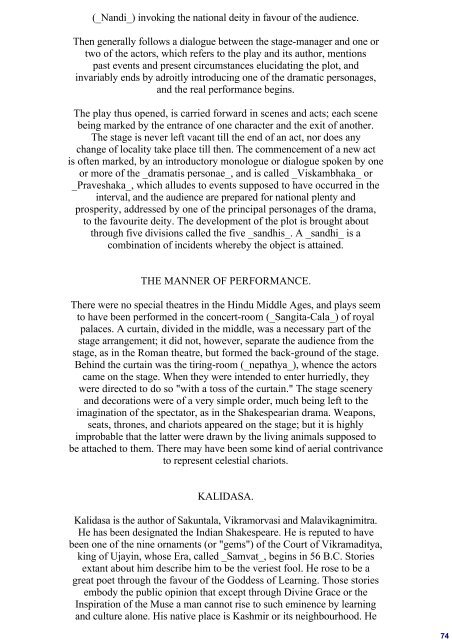TALES FROM THE HINDU DRAMATISTS - Awaken Video
TALES FROM THE HINDU DRAMATISTS - Awaken Video
TALES FROM THE HINDU DRAMATISTS - Awaken Video
You also want an ePaper? Increase the reach of your titles
YUMPU automatically turns print PDFs into web optimized ePapers that Google loves.
(_Nandi_) invoking the national deity in favour of the audience.<br />
Then generally follows a dialogue between the stage-manager and one or<br />
two of the actors, which refers to the play and its author, mentions<br />
past events and present circumstances elucidating the plot, and<br />
invariably ends by adroitly introducing one of the dramatic personages,<br />
and the real performance begins.<br />
The play thus opened, is carried forward in scenes and acts; each scene<br />
being marked by the entrance of one character and the exit of another.<br />
The stage is never left vacant till the end of an act, nor does any<br />
change of locality take place till then. The commencement of a new act<br />
is often marked, by an introductory monologue or dialogue spoken by one<br />
or more of the _dramatis personae_, and is called _Viskambhaka_ or<br />
_Praveshaka_, which alludes to events supposed to have occurred in the<br />
interval, and the audience are prepared for national plenty and<br />
prosperity, addressed by one of the principal personages of the drama,<br />
to the favourite deity. The development of the plot is brought about<br />
through five divisions called the five _sandhis_. A _sandhi_ is a<br />
combination of incidents whereby the object is attained.<br />
<strong>THE</strong> MANNER OF PERFORMANCE.<br />
There were no special theatres in the Hindu Middle Ages, and plays seem<br />
to have been performed in the concert-room (_Sangita-Cala_) of royal<br />
palaces. A curtain, divided in the middle, was a necessary part of the<br />
stage arrangement; it did not, however, separate the audience from the<br />
stage, as in the Roman theatre, but formed the back-ground of the stage.<br />
Behind the curtain was the tiring-room (_nepathya_), whence the actors<br />
came on the stage. When they were intended to enter hurriedly, they<br />
were directed to do so "with a toss of the curtain." The stage scenery<br />
and decorations were of a very simple order, much being left to the<br />
imagination of the spectator, as in the Shakespearian drama. Weapons,<br />
seats, thrones, and chariots appeared on the stage; but it is highly<br />
improbable that the latter were drawn by the living animals supposed to<br />
be attached to them. There may have been some kind of aerial contrivance<br />
to represent celestial chariots.<br />
KALIDASA.<br />
Kalidasa is the author of Sakuntala, Vikramorvasi and Malavikagnimitra.<br />
He has been designated the Indian Shakespeare. He is reputed to have<br />
been one of the nine ornaments (or "gems") of the Court of Vikramaditya,<br />
king of Ujayin, whose Era, called _Samvat_, begins in 56 B.C. Stories<br />
extant about him describe him to be the veriest fool. He rose to be a<br />
great poet through the favour of the Goddess of Learning. Those stories<br />
embody the public opinion that except through Divine Grace or the<br />
Inspiration of the Muse a man cannot rise to such eminence by learning<br />
and culture alone. His native place is Kashmir or its neighbourhood. He<br />
74
















